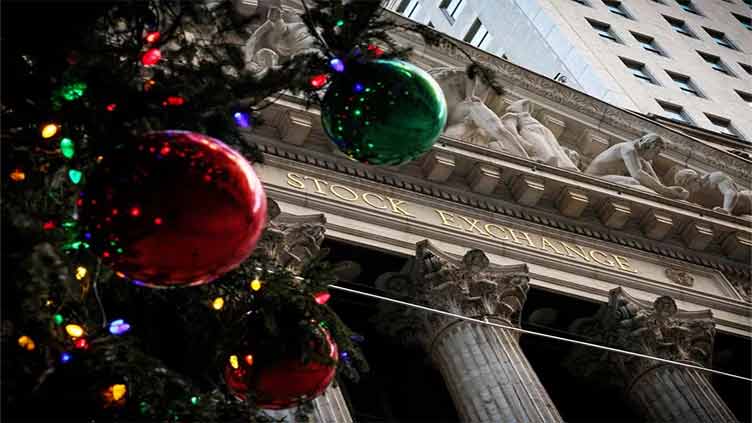Shares dip to cap stellar year; Treasuries end volatile 2023 flat

Business
Shares dip to cap stellar year; Treasuries end volatile 2023 flat
(Reuters) - World shares ticked down on the last trading day of the year but were headed for their biggest annual rise since 2019, while U.S. Treasuries were set to finish the year broadly where they started after some wild moves for the benchmark in 2023.
Shares around the world have risen sharply in the last two months of the year, as benchmark bond yields fell on expectations of central bank rate cuts early in 2023.
The S&P 500 (.SPX) closed on Thursday just 0.3% shy of its record closing high, reached on Jan. 3, 2022. On Friday, the S&P 500 lost 0.48%, the Dow Jones Industrial Average (.DJI) fell 0.27%, and the Nasdaq Composite (.IXIC) dropped 0.84%.
"With New Year’s and record-high territory quickly approaching, investors have the champagne on ice going into the holiday weekend," Adam Turnquist, Chief Technical Strategist for LPL Financial, said in an email. "While extremely overbought conditions raise the odds of a temporary pause or pullback, longer-term returns have been positive and above average based on comparable periods."
The S&P 500 is up about 24% this year thanks to a massive rally in megacap tech stocks, while Europe's STOXX 600, (.STOXX) currently around a 23-month peak, is heading for a nearly 13% yearly gain, and MSCI's world share index a 20% gain, its most in four years. (.MIWD00000PUS). All rallied sharply in November and December.
"We have eaten a lot of the returns that were expected in 2024. The positive momentum in markets is obviously associated with the fall in yields, and so now the question is how long can this trend continue?" said Samy Chaar, chief economist at Lombard Odier.
Chaar said that future returns "are probably more moderate" than they were at the beginning of November, but if long term U.S. interest rates settle around 3.5% or 4%, there is "little danger of a big U-turn" and continued corporate profits might add "a few percent of upside."
The benchmark 10-year Treasury yield was 3.855%, up 0.5 basis points on the day, and remarkably right around its level at the start of the year.
That yearly performance masks some major swings, as the note's yield reached 5.021% in October, its highest since 2007, before retreating and driving the share rally.
Behind the move lower in yields has been a sustained decline in inflation around the world that has driven expectations that central banks will cut interest rates early next year. The U.S. economy has remained strong feeding hopes for a "soft landing".
Markets are pricing in a 88% chance of the U.S. Federal Reserve starting rate cuts in March, according to CME FedWatch tool, up sharply from a 35% chance at the end of November. Traders are also pricing in over 150 basis points of easing next year by the Fed, the European Central Bank, and the Bank of England.
Spanish inflation was a rare piece of economic data during the quiet period between Christmas and New Year. The country's European Union-harmonised 12-month inflation was unchanged from November at 3.3%, though below the 3.4% expected by analysts polled by Reuters.



